Comprehensive Analysis of Mobile Business Solutions and Implementation
VerifiedAdded on 2021/05/27
|7
|2180
|37
Report
AI Summary
This report provides a comprehensive analysis of mobile business solutions, also known as m-commerce, examining their technical details, key success factors, and associated costs. It explores various platforms, technologies, and the importance of mobile user experience, time to market, security, and workplace flexibility. The report delves into the pros and cons of implementing mobile business solutions, including increased productivity, agility, and flexibility, while also addressing security concerns and cost considerations. It concludes by highlighting the rapid growth and potential of m-commerce, emphasizing its increasing importance in the business landscape. The report also provides insights into the components and challenges of mobile-based systems, along with the key success factors and cost analysis of implementing mobile business solutions. The report also includes a discussion of the benefits, limitations, and the future of mobile commerce. The report is a valuable resource for students and professionals seeking to understand the intricacies of mobile business solutions and their impact on organizations.

Contents
Introduction...........................................................................................................................................2
Technologies and Platform details.........................................................................................................2
Key success factors................................................................................................................................3
Cost Analysis.........................................................................................................................................5
Pros and Cons........................................................................................................................................5
Conclusion.............................................................................................................................................6
References.............................................................................................................................................6
1
Introduction...........................................................................................................................................2
Technologies and Platform details.........................................................................................................2
Key success factors................................................................................................................................3
Cost Analysis.........................................................................................................................................5
Pros and Cons........................................................................................................................................5
Conclusion.............................................................................................................................................6
References.............................................................................................................................................6
1
Paraphrase This Document
Need a fresh take? Get an instant paraphrase of this document with our AI Paraphraser
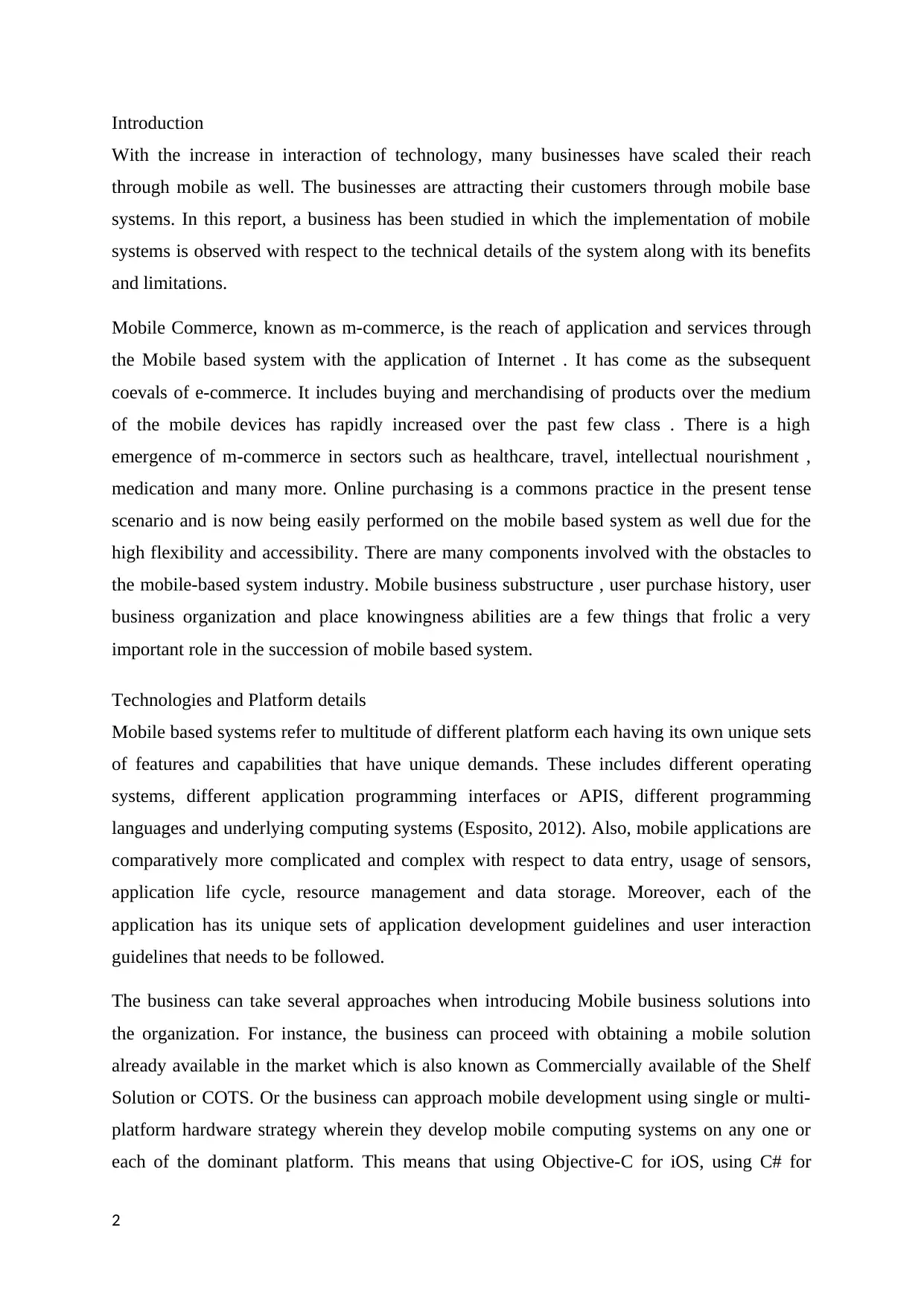
Introduction
With the increase in interaction of technology, many businesses have scaled their reach
through mobile as well. The businesses are attracting their customers through mobile base
systems. In this report, a business has been studied in which the implementation of mobile
systems is observed with respect to the technical details of the system along with its benefits
and limitations.
Mobile Commerce, known as m-commerce, is the reach of application and services through
the Mobile based system with the application of Internet . It has come as the subsequent
coevals of e-commerce. It includes buying and merchandising of products over the medium
of the mobile devices has rapidly increased over the past few class . There is a high
emergence of m-commerce in sectors such as healthcare, travel, intellectual nourishment ,
medication and many more. Online purchasing is a commons practice in the present tense
scenario and is now being easily performed on the mobile based system as well due for the
high flexibility and accessibility. There are many components involved with the obstacles to
the mobile-based system industry. Mobile business substructure , user purchase history, user
business organization and place knowingness abilities are a few things that frolic a very
important role in the succession of mobile based system.
Technologies and Platform details
Mobile based systems refer to multitude of different platform each having its own unique sets
of features and capabilities that have unique demands. These includes different operating
systems, different application programming interfaces or APIS, different programming
languages and underlying computing systems (Esposito, 2012). Also, mobile applications are
comparatively more complicated and complex with respect to data entry, usage of sensors,
application life cycle, resource management and data storage. Moreover, each of the
application has its unique sets of application development guidelines and user interaction
guidelines that needs to be followed.
The business can take several approaches when introducing Mobile business solutions into
the organization. For instance, the business can proceed with obtaining a mobile solution
already available in the market which is also known as Commercially available of the Shelf
Solution or COTS. Or the business can approach mobile development using single or multi-
platform hardware strategy wherein they develop mobile computing systems on any one or
each of the dominant platform. This means that using Objective-C for iOS, using C# for
2
With the increase in interaction of technology, many businesses have scaled their reach
through mobile as well. The businesses are attracting their customers through mobile base
systems. In this report, a business has been studied in which the implementation of mobile
systems is observed with respect to the technical details of the system along with its benefits
and limitations.
Mobile Commerce, known as m-commerce, is the reach of application and services through
the Mobile based system with the application of Internet . It has come as the subsequent
coevals of e-commerce. It includes buying and merchandising of products over the medium
of the mobile devices has rapidly increased over the past few class . There is a high
emergence of m-commerce in sectors such as healthcare, travel, intellectual nourishment ,
medication and many more. Online purchasing is a commons practice in the present tense
scenario and is now being easily performed on the mobile based system as well due for the
high flexibility and accessibility. There are many components involved with the obstacles to
the mobile-based system industry. Mobile business substructure , user purchase history, user
business organization and place knowingness abilities are a few things that frolic a very
important role in the succession of mobile based system.
Technologies and Platform details
Mobile based systems refer to multitude of different platform each having its own unique sets
of features and capabilities that have unique demands. These includes different operating
systems, different application programming interfaces or APIS, different programming
languages and underlying computing systems (Esposito, 2012). Also, mobile applications are
comparatively more complicated and complex with respect to data entry, usage of sensors,
application life cycle, resource management and data storage. Moreover, each of the
application has its unique sets of application development guidelines and user interaction
guidelines that needs to be followed.
The business can take several approaches when introducing Mobile business solutions into
the organization. For instance, the business can proceed with obtaining a mobile solution
already available in the market which is also known as Commercially available of the Shelf
Solution or COTS. Or the business can approach mobile development using single or multi-
platform hardware strategy wherein they develop mobile computing systems on any one or
each of the dominant platform. This means that using Objective-C for iOS, using C# for
2
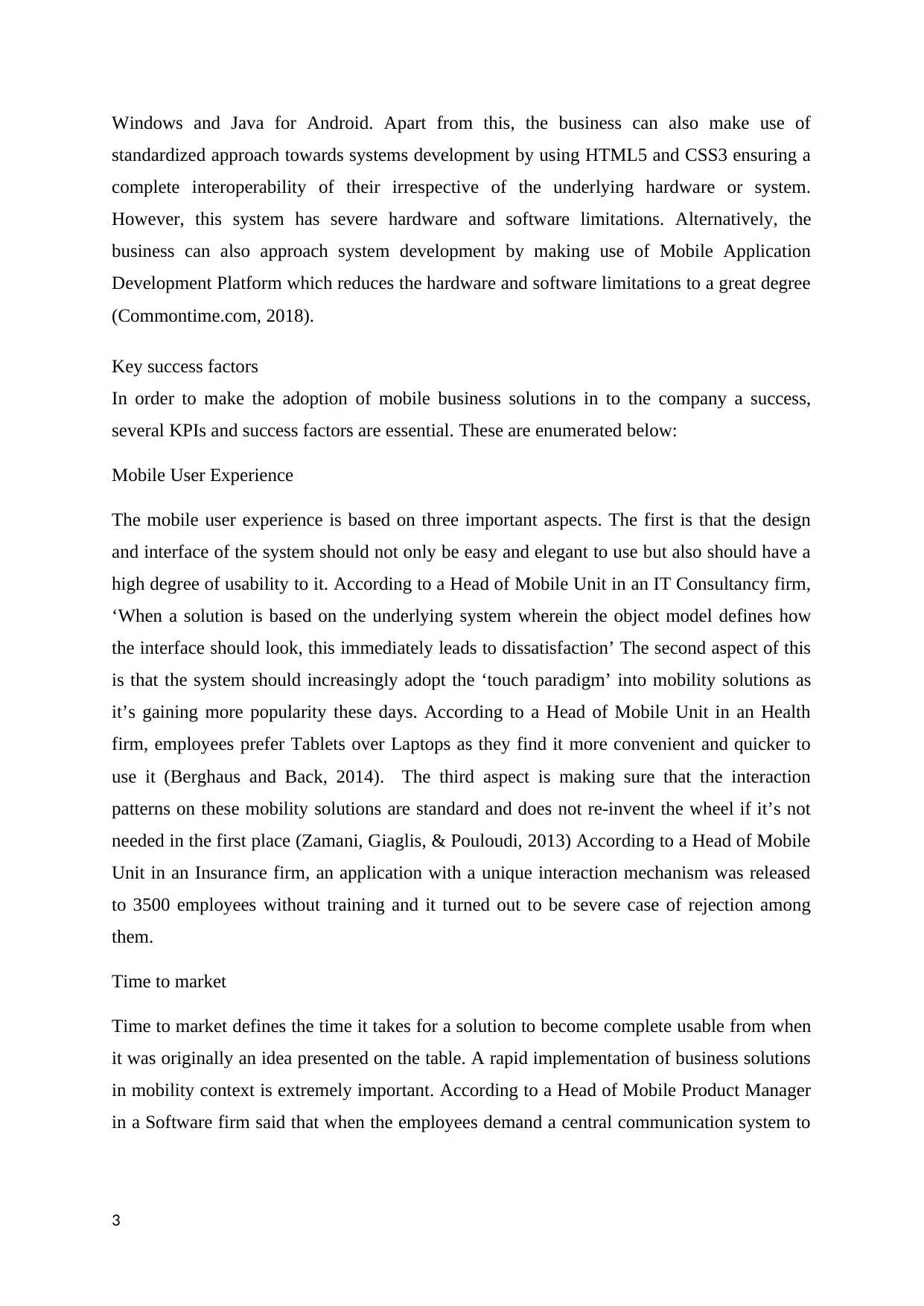
Windows and Java for Android. Apart from this, the business can also make use of
standardized approach towards systems development by using HTML5 and CSS3 ensuring a
complete interoperability of their irrespective of the underlying hardware or system.
However, this system has severe hardware and software limitations. Alternatively, the
business can also approach system development by making use of Mobile Application
Development Platform which reduces the hardware and software limitations to a great degree
(Commontime.com, 2018).
Key success factors
In order to make the adoption of mobile business solutions in to the company a success,
several KPIs and success factors are essential. These are enumerated below:
Mobile User Experience
The mobile user experience is based on three important aspects. The first is that the design
and interface of the system should not only be easy and elegant to use but also should have a
high degree of usability to it. According to a Head of Mobile Unit in an IT Consultancy firm,
‘When a solution is based on the underlying system wherein the object model defines how
the interface should look, this immediately leads to dissatisfaction’ The second aspect of this
is that the system should increasingly adopt the ‘touch paradigm’ into mobility solutions as
it’s gaining more popularity these days. According to a Head of Mobile Unit in an Health
firm, employees prefer Tablets over Laptops as they find it more convenient and quicker to
use it (Berghaus and Back, 2014). The third aspect is making sure that the interaction
patterns on these mobility solutions are standard and does not re-invent the wheel if it’s not
needed in the first place (Zamani, Giaglis, & Pouloudi, 2013) According to a Head of Mobile
Unit in an Insurance firm, an application with a unique interaction mechanism was released
to 3500 employees without training and it turned out to be severe case of rejection among
them.
Time to market
Time to market defines the time it takes for a solution to become complete usable from when
it was originally an idea presented on the table. A rapid implementation of business solutions
in mobility context is extremely important. According to a Head of Mobile Product Manager
in a Software firm said that when the employees demand a central communication system to
3
standardized approach towards systems development by using HTML5 and CSS3 ensuring a
complete interoperability of their irrespective of the underlying hardware or system.
However, this system has severe hardware and software limitations. Alternatively, the
business can also approach system development by making use of Mobile Application
Development Platform which reduces the hardware and software limitations to a great degree
(Commontime.com, 2018).
Key success factors
In order to make the adoption of mobile business solutions in to the company a success,
several KPIs and success factors are essential. These are enumerated below:
Mobile User Experience
The mobile user experience is based on three important aspects. The first is that the design
and interface of the system should not only be easy and elegant to use but also should have a
high degree of usability to it. According to a Head of Mobile Unit in an IT Consultancy firm,
‘When a solution is based on the underlying system wherein the object model defines how
the interface should look, this immediately leads to dissatisfaction’ The second aspect of this
is that the system should increasingly adopt the ‘touch paradigm’ into mobility solutions as
it’s gaining more popularity these days. According to a Head of Mobile Unit in an Health
firm, employees prefer Tablets over Laptops as they find it more convenient and quicker to
use it (Berghaus and Back, 2014). The third aspect is making sure that the interaction
patterns on these mobility solutions are standard and does not re-invent the wheel if it’s not
needed in the first place (Zamani, Giaglis, & Pouloudi, 2013) According to a Head of Mobile
Unit in an Insurance firm, an application with a unique interaction mechanism was released
to 3500 employees without training and it turned out to be severe case of rejection among
them.
Time to market
Time to market defines the time it takes for a solution to become complete usable from when
it was originally an idea presented on the table. A rapid implementation of business solutions
in mobility context is extremely important. According to a Head of Mobile Product Manager
in a Software firm said that when the employees demand a central communication system to
3
⊘ This is a preview!⊘
Do you want full access?
Subscribe today to unlock all pages.

Trusted by 1+ million students worldwide
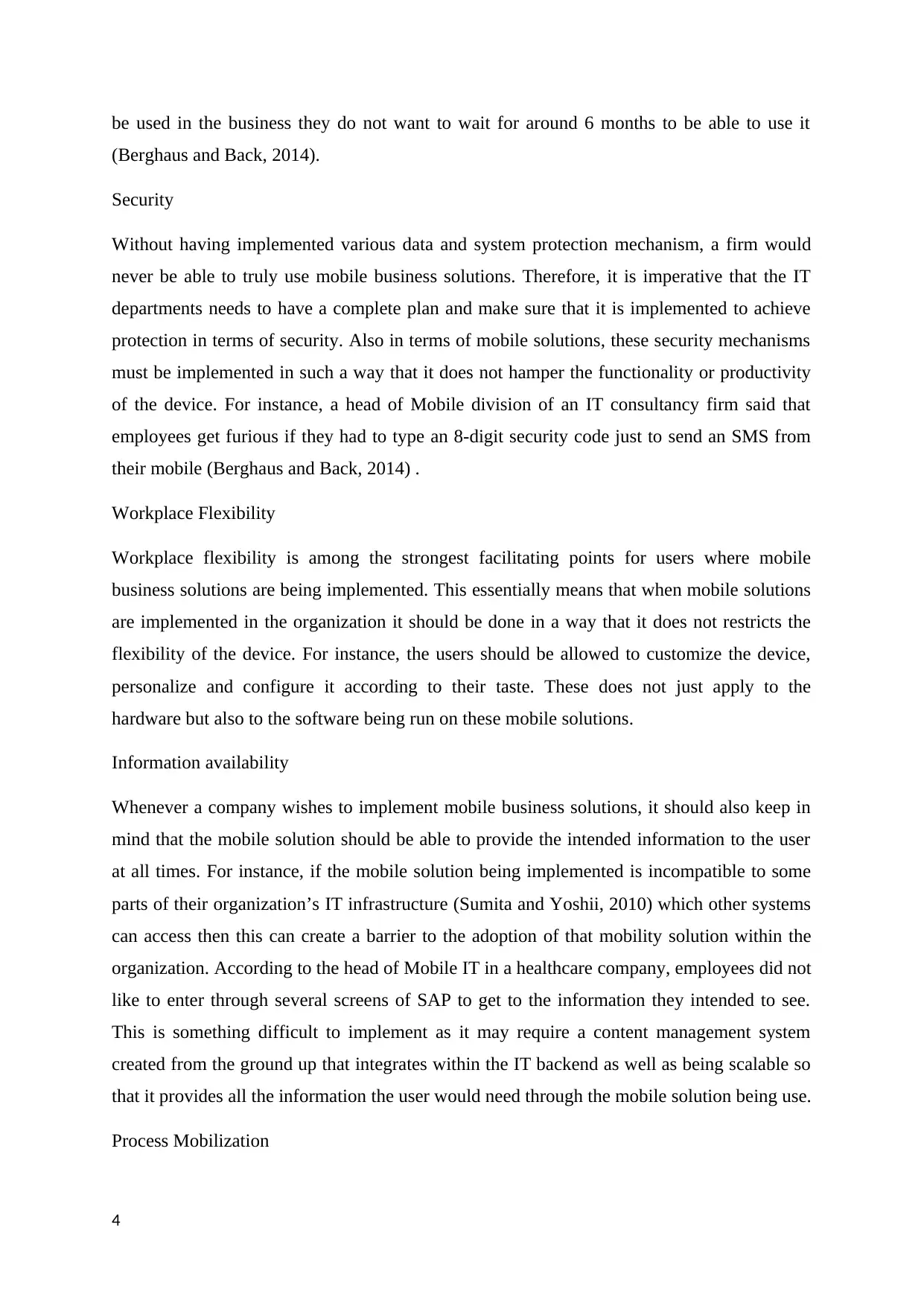
be used in the business they do not want to wait for around 6 months to be able to use it
(Berghaus and Back, 2014).
Security
Without having implemented various data and system protection mechanism, a firm would
never be able to truly use mobile business solutions. Therefore, it is imperative that the IT
departments needs to have a complete plan and make sure that it is implemented to achieve
protection in terms of security. Also in terms of mobile solutions, these security mechanisms
must be implemented in such a way that it does not hamper the functionality or productivity
of the device. For instance, a head of Mobile division of an IT consultancy firm said that
employees get furious if they had to type an 8-digit security code just to send an SMS from
their mobile (Berghaus and Back, 2014) .
Workplace Flexibility
Workplace flexibility is among the strongest facilitating points for users where mobile
business solutions are being implemented. This essentially means that when mobile solutions
are implemented in the organization it should be done in a way that it does not restricts the
flexibility of the device. For instance, the users should be allowed to customize the device,
personalize and configure it according to their taste. These does not just apply to the
hardware but also to the software being run on these mobile solutions.
Information availability
Whenever a company wishes to implement mobile business solutions, it should also keep in
mind that the mobile solution should be able to provide the intended information to the user
at all times. For instance, if the mobile solution being implemented is incompatible to some
parts of their organization’s IT infrastructure (Sumita and Yoshii, 2010) which other systems
can access then this can create a barrier to the adoption of that mobility solution within the
organization. According to the head of Mobile IT in a healthcare company, employees did not
like to enter through several screens of SAP to get to the information they intended to see.
This is something difficult to implement as it may require a content management system
created from the ground up that integrates within the IT backend as well as being scalable so
that it provides all the information the user would need through the mobile solution being use.
Process Mobilization
4
(Berghaus and Back, 2014).
Security
Without having implemented various data and system protection mechanism, a firm would
never be able to truly use mobile business solutions. Therefore, it is imperative that the IT
departments needs to have a complete plan and make sure that it is implemented to achieve
protection in terms of security. Also in terms of mobile solutions, these security mechanisms
must be implemented in such a way that it does not hamper the functionality or productivity
of the device. For instance, a head of Mobile division of an IT consultancy firm said that
employees get furious if they had to type an 8-digit security code just to send an SMS from
their mobile (Berghaus and Back, 2014) .
Workplace Flexibility
Workplace flexibility is among the strongest facilitating points for users where mobile
business solutions are being implemented. This essentially means that when mobile solutions
are implemented in the organization it should be done in a way that it does not restricts the
flexibility of the device. For instance, the users should be allowed to customize the device,
personalize and configure it according to their taste. These does not just apply to the
hardware but also to the software being run on these mobile solutions.
Information availability
Whenever a company wishes to implement mobile business solutions, it should also keep in
mind that the mobile solution should be able to provide the intended information to the user
at all times. For instance, if the mobile solution being implemented is incompatible to some
parts of their organization’s IT infrastructure (Sumita and Yoshii, 2010) which other systems
can access then this can create a barrier to the adoption of that mobility solution within the
organization. According to the head of Mobile IT in a healthcare company, employees did not
like to enter through several screens of SAP to get to the information they intended to see.
This is something difficult to implement as it may require a content management system
created from the ground up that integrates within the IT backend as well as being scalable so
that it provides all the information the user would need through the mobile solution being use.
Process Mobilization
4
Paraphrase This Document
Need a fresh take? Get an instant paraphrase of this document with our AI Paraphraser
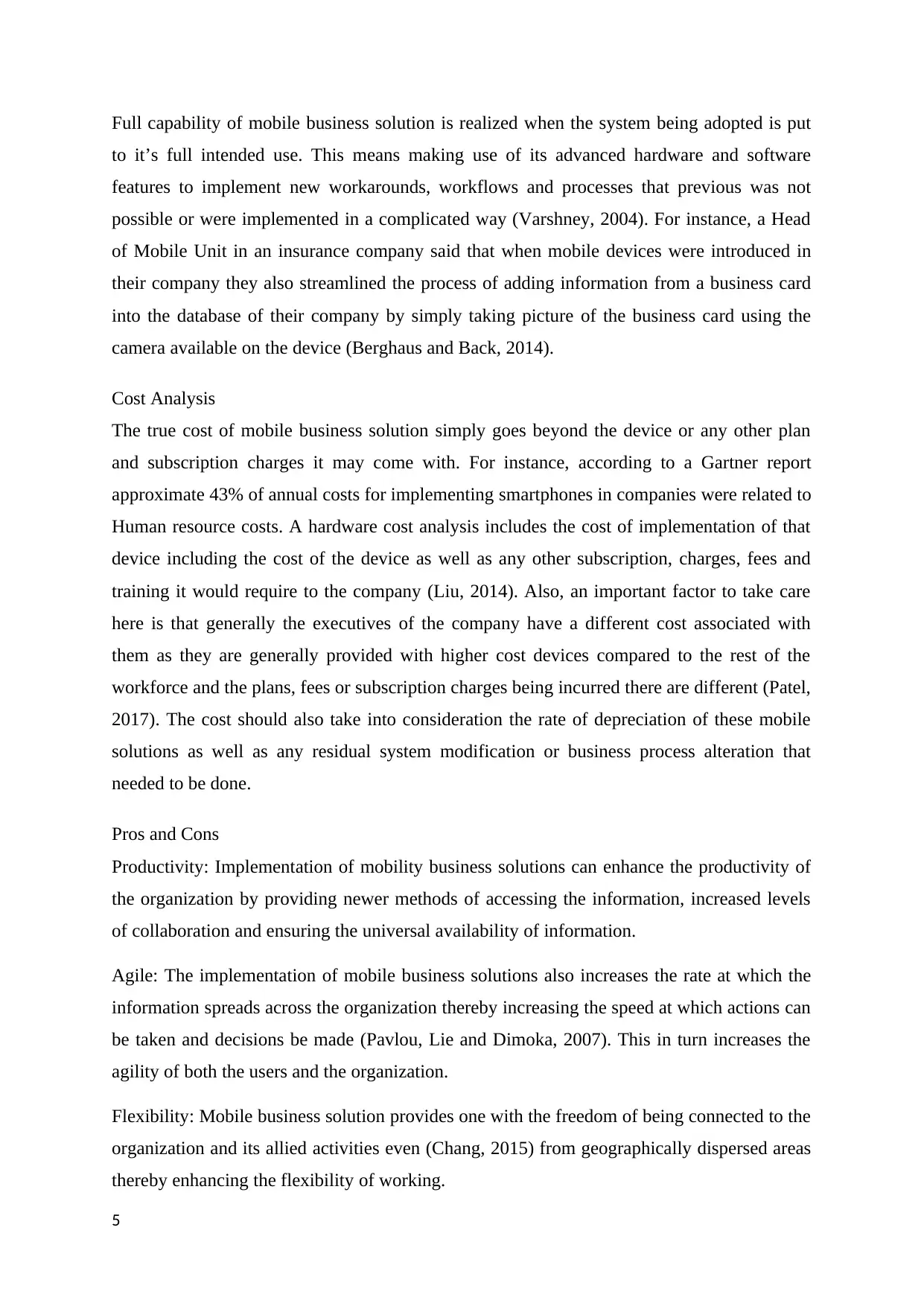
Full capability of mobile business solution is realized when the system being adopted is put
to it’s full intended use. This means making use of its advanced hardware and software
features to implement new workarounds, workflows and processes that previous was not
possible or were implemented in a complicated way (Varshney, 2004). For instance, a Head
of Mobile Unit in an insurance company said that when mobile devices were introduced in
their company they also streamlined the process of adding information from a business card
into the database of their company by simply taking picture of the business card using the
camera available on the device (Berghaus and Back, 2014).
Cost Analysis
The true cost of mobile business solution simply goes beyond the device or any other plan
and subscription charges it may come with. For instance, according to a Gartner report
approximate 43% of annual costs for implementing smartphones in companies were related to
Human resource costs. A hardware cost analysis includes the cost of implementation of that
device including the cost of the device as well as any other subscription, charges, fees and
training it would require to the company (Liu, 2014). Also, an important factor to take care
here is that generally the executives of the company have a different cost associated with
them as they are generally provided with higher cost devices compared to the rest of the
workforce and the plans, fees or subscription charges being incurred there are different (Patel,
2017). The cost should also take into consideration the rate of depreciation of these mobile
solutions as well as any residual system modification or business process alteration that
needed to be done.
Pros and Cons
Productivity: Implementation of mobility business solutions can enhance the productivity of
the organization by providing newer methods of accessing the information, increased levels
of collaboration and ensuring the universal availability of information.
Agile: The implementation of mobile business solutions also increases the rate at which the
information spreads across the organization thereby increasing the speed at which actions can
be taken and decisions be made (Pavlou, Lie and Dimoka, 2007). This in turn increases the
agility of both the users and the organization.
Flexibility: Mobile business solution provides one with the freedom of being connected to the
organization and its allied activities even (Chang, 2015) from geographically dispersed areas
thereby enhancing the flexibility of working.
5
to it’s full intended use. This means making use of its advanced hardware and software
features to implement new workarounds, workflows and processes that previous was not
possible or were implemented in a complicated way (Varshney, 2004). For instance, a Head
of Mobile Unit in an insurance company said that when mobile devices were introduced in
their company they also streamlined the process of adding information from a business card
into the database of their company by simply taking picture of the business card using the
camera available on the device (Berghaus and Back, 2014).
Cost Analysis
The true cost of mobile business solution simply goes beyond the device or any other plan
and subscription charges it may come with. For instance, according to a Gartner report
approximate 43% of annual costs for implementing smartphones in companies were related to
Human resource costs. A hardware cost analysis includes the cost of implementation of that
device including the cost of the device as well as any other subscription, charges, fees and
training it would require to the company (Liu, 2014). Also, an important factor to take care
here is that generally the executives of the company have a different cost associated with
them as they are generally provided with higher cost devices compared to the rest of the
workforce and the plans, fees or subscription charges being incurred there are different (Patel,
2017). The cost should also take into consideration the rate of depreciation of these mobile
solutions as well as any residual system modification or business process alteration that
needed to be done.
Pros and Cons
Productivity: Implementation of mobility business solutions can enhance the productivity of
the organization by providing newer methods of accessing the information, increased levels
of collaboration and ensuring the universal availability of information.
Agile: The implementation of mobile business solutions also increases the rate at which the
information spreads across the organization thereby increasing the speed at which actions can
be taken and decisions be made (Pavlou, Lie and Dimoka, 2007). This in turn increases the
agility of both the users and the organization.
Flexibility: Mobile business solution provides one with the freedom of being connected to the
organization and its allied activities even (Chang, 2015) from geographically dispersed areas
thereby enhancing the flexibility of working.
5
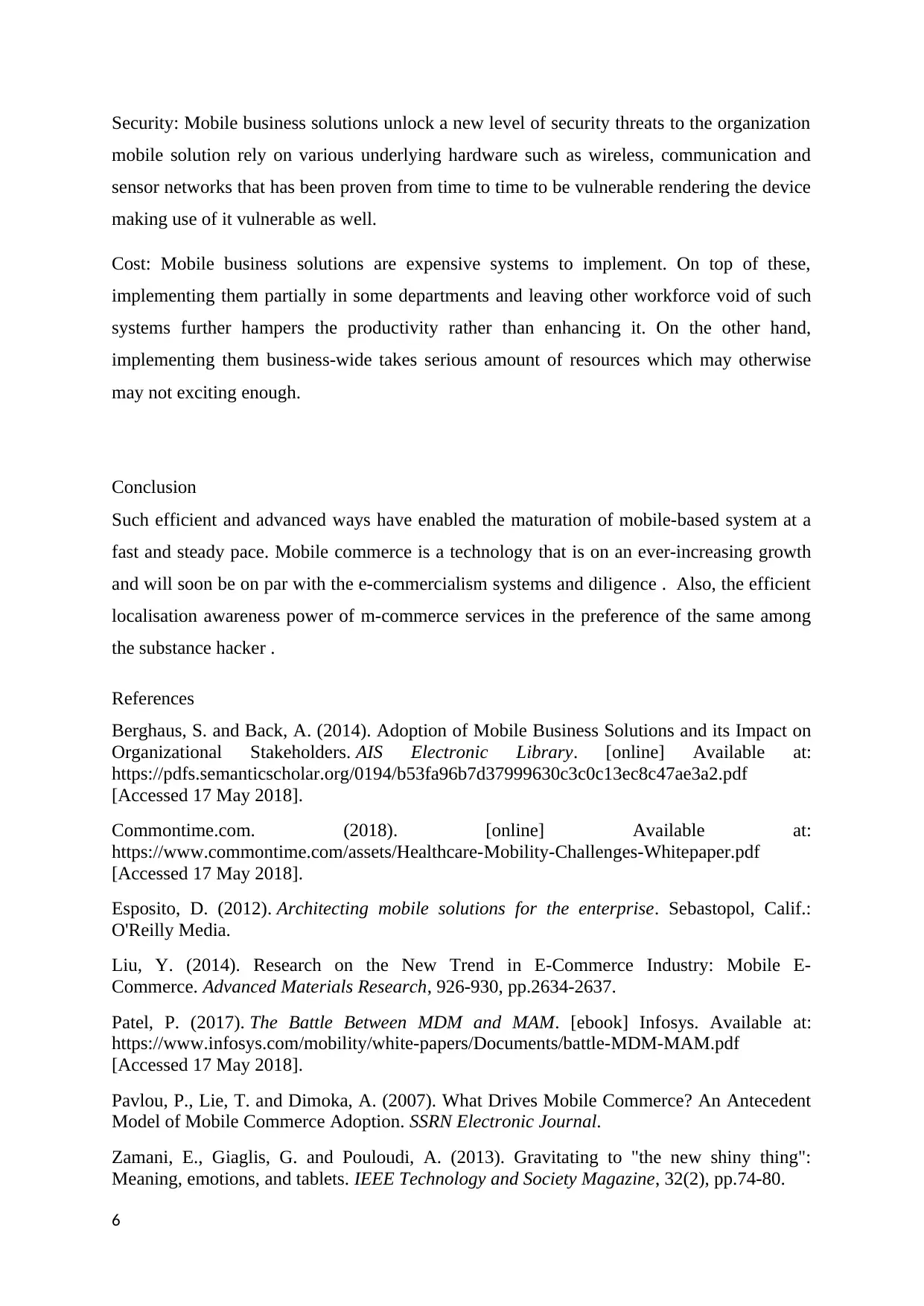
Security: Mobile business solutions unlock a new level of security threats to the organization
mobile solution rely on various underlying hardware such as wireless, communication and
sensor networks that has been proven from time to time to be vulnerable rendering the device
making use of it vulnerable as well.
Cost: Mobile business solutions are expensive systems to implement. On top of these,
implementing them partially in some departments and leaving other workforce void of such
systems further hampers the productivity rather than enhancing it. On the other hand,
implementing them business-wide takes serious amount of resources which may otherwise
may not exciting enough.
Conclusion
Such efficient and advanced ways have enabled the maturation of mobile-based system at a
fast and steady pace. Mobile commerce is a technology that is on an ever-increasing growth
and will soon be on par with the e-commercialism systems and diligence . Also, the efficient
localisation awareness power of m-commerce services in the preference of the same among
the substance hacker .
References
Berghaus, S. and Back, A. (2014). Adoption of Mobile Business Solutions and its Impact on
Organizational Stakeholders. AIS Electronic Library. [online] Available at:
https://pdfs.semanticscholar.org/0194/b53fa96b7d37999630c3c0c13ec8c47ae3a2.pdf
[Accessed 17 May 2018].
Commontime.com. (2018). [online] Available at:
https://www.commontime.com/assets/Healthcare-Mobility-Challenges-Whitepaper.pdf
[Accessed 17 May 2018].
Esposito, D. (2012). Architecting mobile solutions for the enterprise. Sebastopol, Calif.:
O'Reilly Media.
Liu, Y. (2014). Research on the New Trend in E-Commerce Industry: Mobile E-
Commerce. Advanced Materials Research, 926-930, pp.2634-2637.
Patel, P. (2017). The Battle Between MDM and MAM. [ebook] Infosys. Available at:
https://www.infosys.com/mobility/white-papers/Documents/battle-MDM-MAM.pdf
[Accessed 17 May 2018].
Pavlou, P., Lie, T. and Dimoka, A. (2007). What Drives Mobile Commerce? An Antecedent
Model of Mobile Commerce Adoption. SSRN Electronic Journal.
Zamani, E., Giaglis, G. and Pouloudi, A. (2013). Gravitating to "the new shiny thing":
Meaning, emotions, and tablets. IEEE Technology and Society Magazine, 32(2), pp.74-80.
6
mobile solution rely on various underlying hardware such as wireless, communication and
sensor networks that has been proven from time to time to be vulnerable rendering the device
making use of it vulnerable as well.
Cost: Mobile business solutions are expensive systems to implement. On top of these,
implementing them partially in some departments and leaving other workforce void of such
systems further hampers the productivity rather than enhancing it. On the other hand,
implementing them business-wide takes serious amount of resources which may otherwise
may not exciting enough.
Conclusion
Such efficient and advanced ways have enabled the maturation of mobile-based system at a
fast and steady pace. Mobile commerce is a technology that is on an ever-increasing growth
and will soon be on par with the e-commercialism systems and diligence . Also, the efficient
localisation awareness power of m-commerce services in the preference of the same among
the substance hacker .
References
Berghaus, S. and Back, A. (2014). Adoption of Mobile Business Solutions and its Impact on
Organizational Stakeholders. AIS Electronic Library. [online] Available at:
https://pdfs.semanticscholar.org/0194/b53fa96b7d37999630c3c0c13ec8c47ae3a2.pdf
[Accessed 17 May 2018].
Commontime.com. (2018). [online] Available at:
https://www.commontime.com/assets/Healthcare-Mobility-Challenges-Whitepaper.pdf
[Accessed 17 May 2018].
Esposito, D. (2012). Architecting mobile solutions for the enterprise. Sebastopol, Calif.:
O'Reilly Media.
Liu, Y. (2014). Research on the New Trend in E-Commerce Industry: Mobile E-
Commerce. Advanced Materials Research, 926-930, pp.2634-2637.
Patel, P. (2017). The Battle Between MDM and MAM. [ebook] Infosys. Available at:
https://www.infosys.com/mobility/white-papers/Documents/battle-MDM-MAM.pdf
[Accessed 17 May 2018].
Pavlou, P., Lie, T. and Dimoka, A. (2007). What Drives Mobile Commerce? An Antecedent
Model of Mobile Commerce Adoption. SSRN Electronic Journal.
Zamani, E., Giaglis, G. and Pouloudi, A. (2013). Gravitating to "the new shiny thing":
Meaning, emotions, and tablets. IEEE Technology and Society Magazine, 32(2), pp.74-80.
6
⊘ This is a preview!⊘
Do you want full access?
Subscribe today to unlock all pages.

Trusted by 1+ million students worldwide
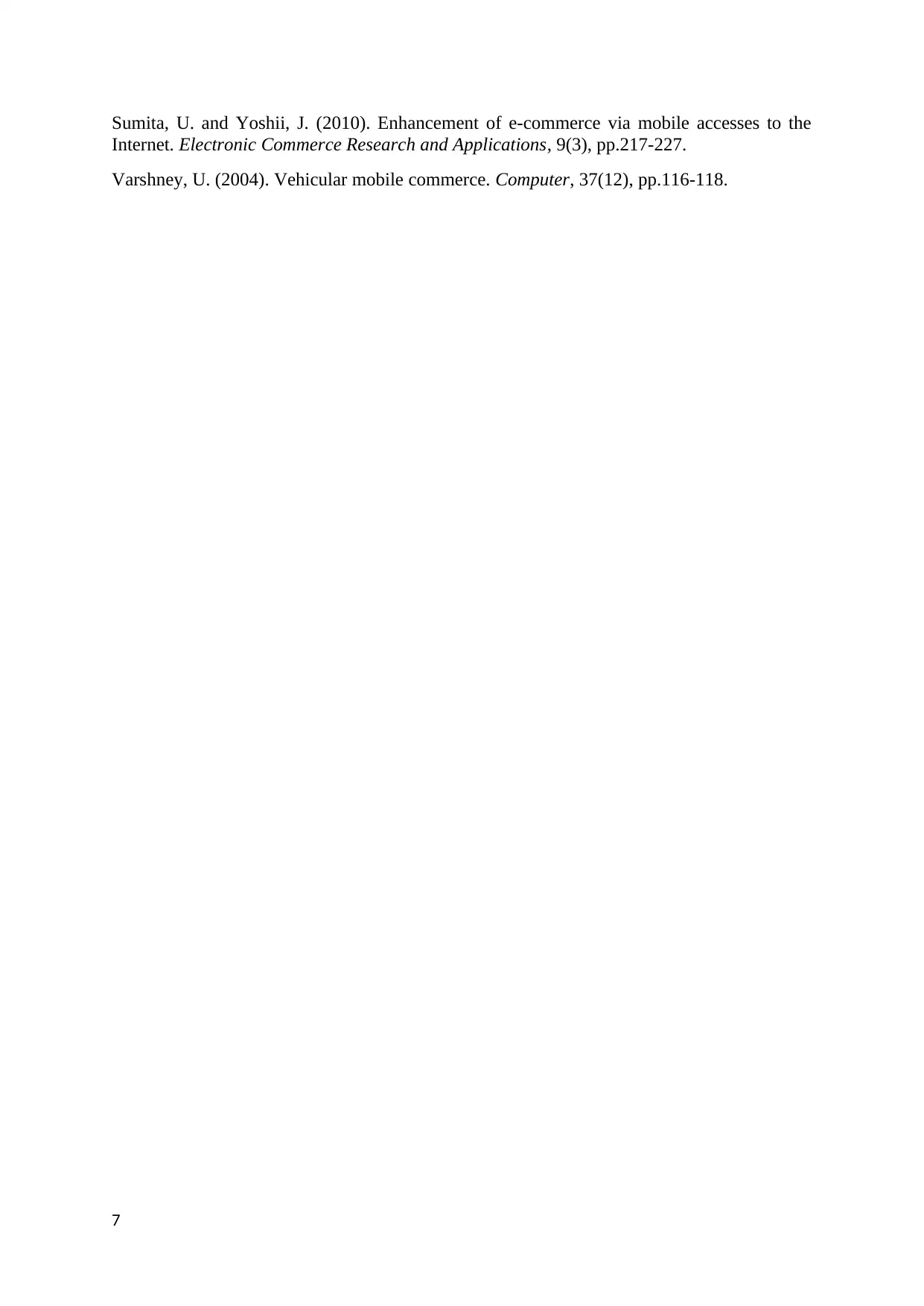
Sumita, U. and Yoshii, J. (2010). Enhancement of e-commerce via mobile accesses to the
Internet. Electronic Commerce Research and Applications, 9(3), pp.217-227.
Varshney, U. (2004). Vehicular mobile commerce. Computer, 37(12), pp.116-118.
7
Internet. Electronic Commerce Research and Applications, 9(3), pp.217-227.
Varshney, U. (2004). Vehicular mobile commerce. Computer, 37(12), pp.116-118.
7
1 out of 7
Related Documents
Your All-in-One AI-Powered Toolkit for Academic Success.
+13062052269
info@desklib.com
Available 24*7 on WhatsApp / Email
![[object Object]](/_next/static/media/star-bottom.7253800d.svg)
Unlock your academic potential
Copyright © 2020–2025 A2Z Services. All Rights Reserved. Developed and managed by ZUCOL.





